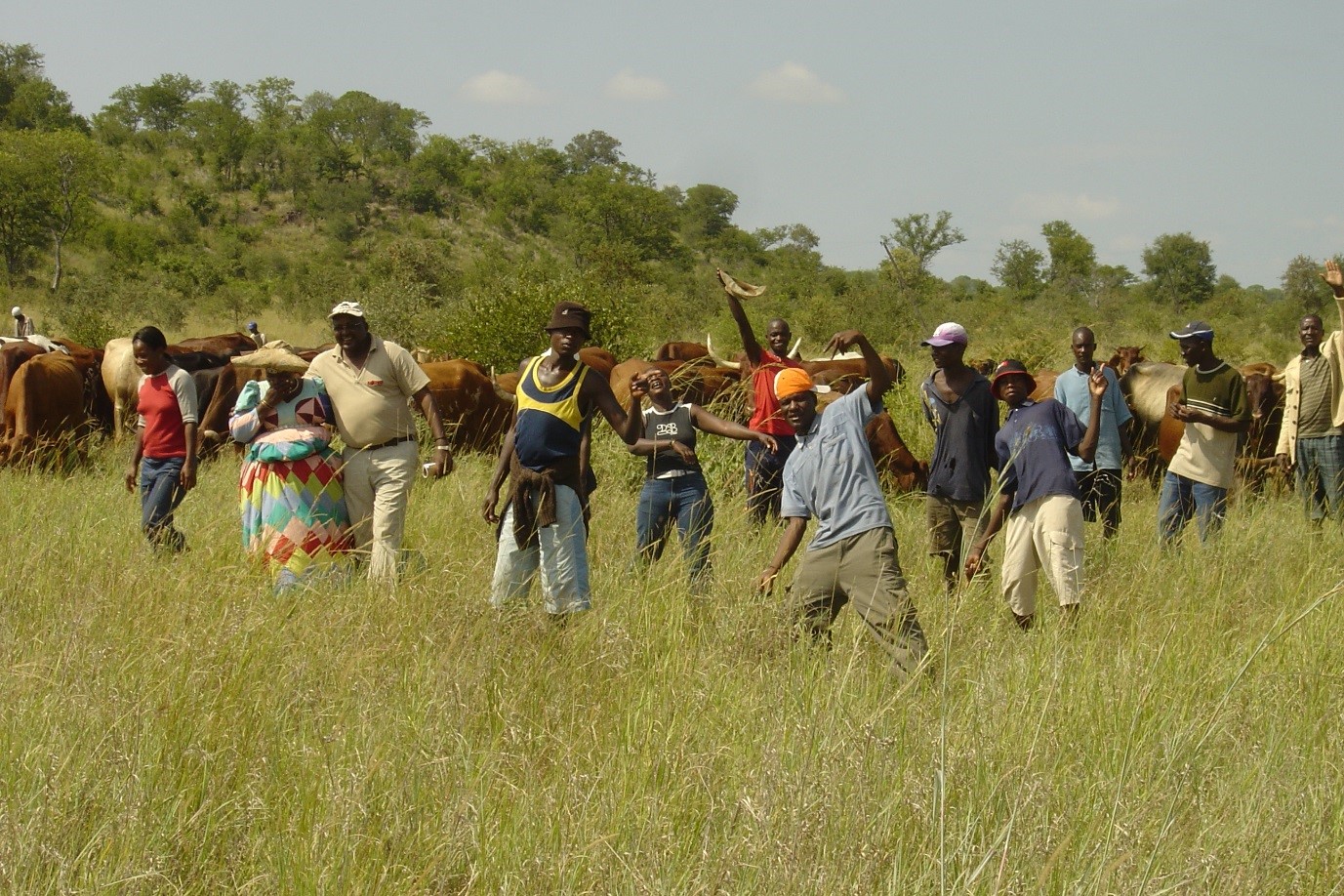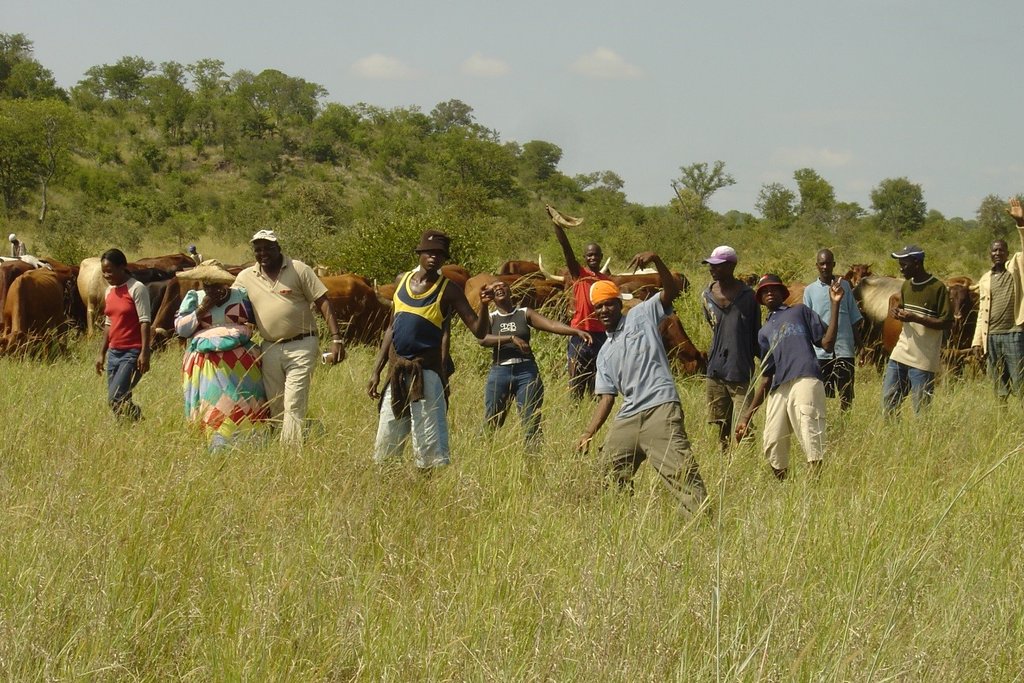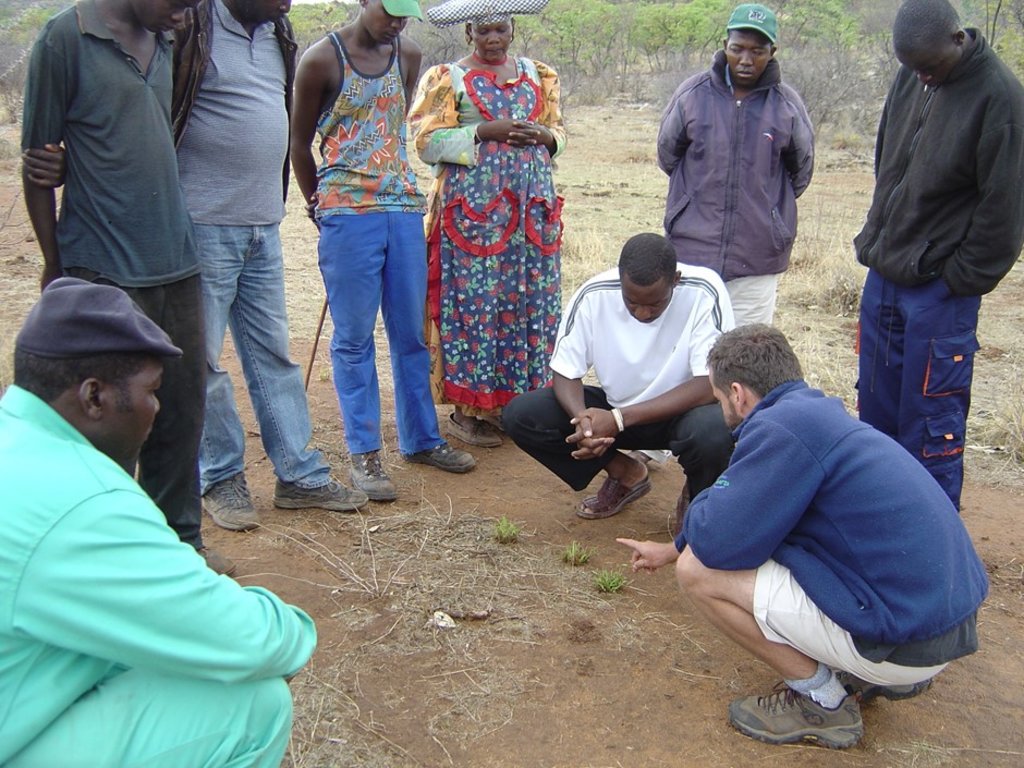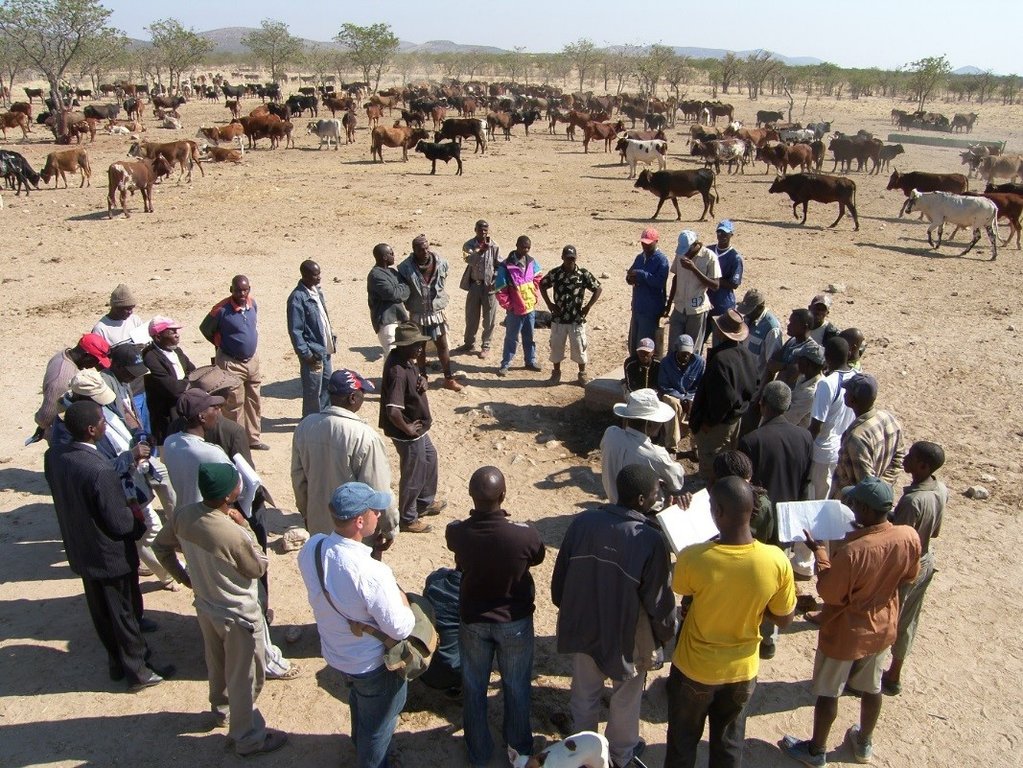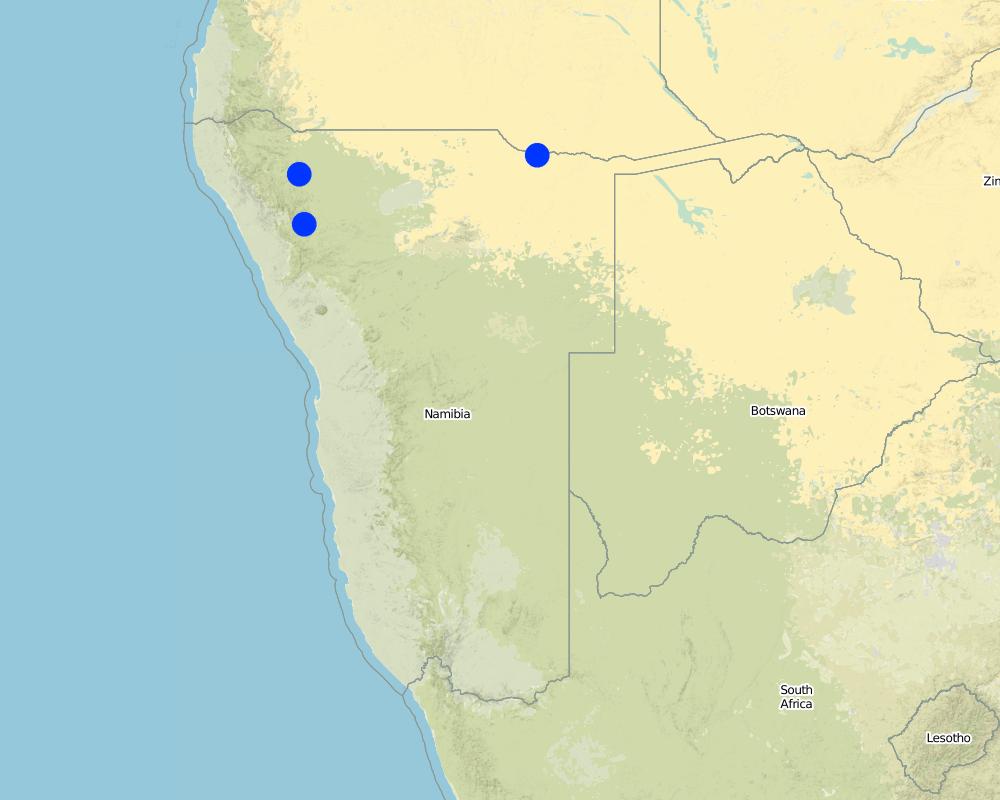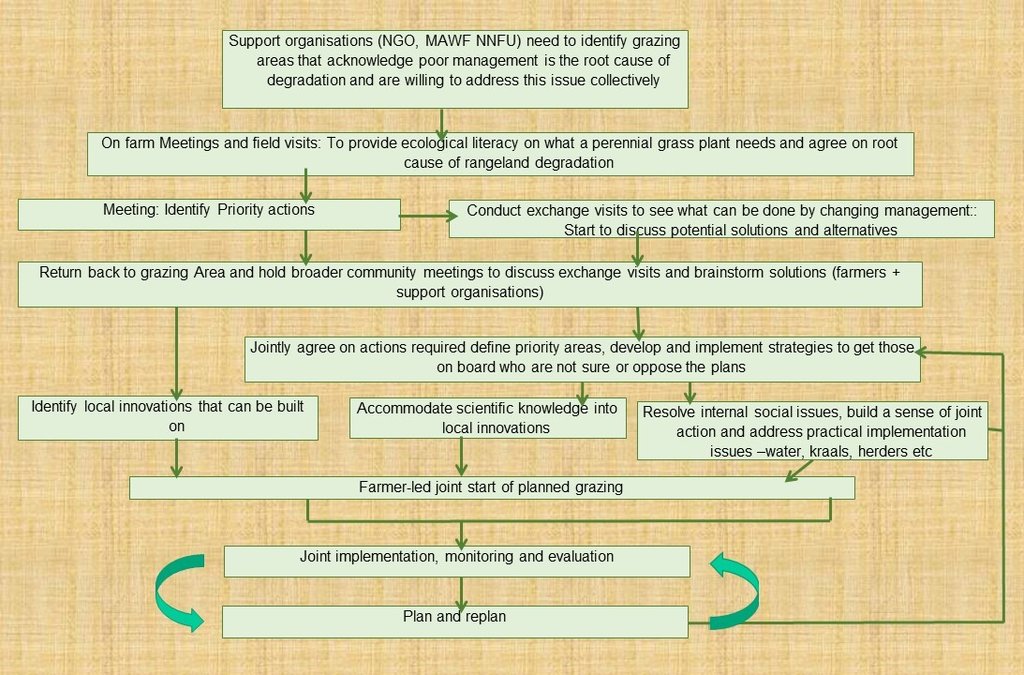Communal grazing management [ប្រទេសណាមីប៊ី]
- ការបង្កើត៖
- បច្ចុប្បន្នភាព
- អ្នកចងក្រង៖ Ibo Zimmermann
- អ្នកកែសម្រួល៖ –
- អ្នកត្រួតពិនិត្យ Rima Mekdaschi Studer
Omarisiro wovinamuinjo motjimbumba
approaches_3050 - ប្រទេសណាមីប៊ី
ពិនិត្យមើលគ្រប់ផ្នែក
ពង្រីកមើលទាំងអស់ បង្រួមទាំងអស់1. ព័ត៌មានទូទៅ
1.2 ព័ត៌មានលម្អិតពីបុគ្គលសំខាន់ៗ និងស្ថាប័នដែលចូលរួមក្នុងការវាយតម្លៃ និងចងក្រងឯកសារនៃវិធីសាស្ត្រផ្សព្វផ្សាយ
អ្នកប្រើប្រាស់ដី:
ឈ្មោះគម្រោងដែលបានចងក្រងឯកសារ/ វាយតម្លៃលើវិធីសាស្ត្រផ្សព្វផ្សាយ (បើទាក់ទង)
Southern African Science Service Centre for climate change and Adaptive Land management (SASSCAL)ឈ្មោះអង្គភាពមួយ (ច្រើន) ដែលបានចងក្រងឯកសារ/ វាយតម្លៃលើវិធីសាស្ត្រផ្សព្វផ្សាយ (បើទាក់ទង)
Conservation Agriculture Namibia (Conservation Agriculture Namibia) - ប្រទេសណាមីប៊ីឈ្មោះអង្គភាពមួយ (ច្រើន) ដែលបានចងក្រងឯកសារ/ វាយតម្លៃលើវិធីសាស្ត្រផ្សព្វផ្សាយ (បើទាក់ទង)
Zakumuka Producers Co-operative (Zakumuka Producers Co-operative) - ប្រទេសណាមីប៊ី1.3 លក្ខខណ្ឌទាក់ទងទៅនឹងការប្រើប្រាស់ទិន្នន័យដែលបានចងក្រងតាមរយៈវ៉ូខេត
តើពេលណាដែលទិន្នន័យបានចងក្រង (នៅទីវាល)?
2017
អ្នកចងក្រង និង(បុគ្គលសំខាន់ៗ)យល់ព្រមទទួលយកនូវលក្ខខណ្ឌនានាទាក់ទងទៅនឹងការប្រើប្រាស់ទិន្នន័យដែលបានចងក្រងតាមរយៈ វ៉ូខេត:
បាទ/ចា៎
1.4 ការយោងមួយ (ច្រើន) ទៅលើ (កម្រង) បញ្ជីសំណួរនៃបច្ចេកទេស SLM
2. ការពណ៌នាអំពីវិធីសាស្ត្រផ្សព្វផ្សាយ SLM
2.1 ពណ៌នាសង្ខេបខ្លីពីវិធីសាស្ត្រផ្សព្វផ្សាយ
Facilitation of agreement among community members to jointly manage their communal grazing area by combining their livestock into a single herd to be driven to different portions of the grazing area. This is done in accordance with an agreed growing season plan that provides sufficient recovery for grazed grasses to reinvigorate themselves and a non-growing season plan to graze perennial grasses and prepare soil and plants for the upcoming growing season for regenerating rangeland productivity and well-being.
2.2 ពណ៌នាលម្អិតពិវិធីសាស្ត្រផ្សព្វផ្សាយ
ពណ៌នាលម្អិតពិវិធីសាស្ត្រផ្សព្វផ្សាយ:
The approach is a partnership between NGO, Ministries of Lands and Agriculture, National Farmers Union, traditional authorities and regional and local government. The NGO facilitates community members to recognise the damage caused to the rangeland by their individual herds of livestock grazing continuously on the same grass plants, and to appreciate the benefits that planned grazing can bring about. Farmers host facilitators on their land where the current state of the land is compared to that of the past and the reasons for the decline are investigated. Once farmers understand that all perennial grass plants need recovery and that continuous grazing depletes the root reserve, the land users soon conclude that it was their management that resulted in the loss of perennial grass and increase in bare ground. Once the root cause of the problem is established, the aim of the approach can be pursued, which is to regenerate rangeland productivity in the communal grazing area and thereby support higher production of livestock to in turn support livelihoods of the community. The focus on rangeland results from identifying and addressing the weakest link in the chain of production (converting sunlight to grass, or grass to meat, or meat to money) in a viable and upscalable manner. If motivation to apply planned grazing exists and there is sufficient cohesion among the community members, then their right to claim common property ownership of their grazing area needs to be established. In these pioneering communities this required at least 10 village level livestock owner meetings each to decide on the modalities of how to start planned grazing. These meetings continue after planned grazing has started to deal with ongoing planning as well as other aspects including animal production and marketing. Exposure visits to areas with successful grazing management helps to motivate community members. On returning home frequent follow-up meetings were facilitated by the same NGO and the Ministry of Agriculture to resolve local issues, which included overcoming traditional taboos, such as combining animals in one overnight kraal as well as whose bulls would be kept in the herd and how this would be managed. Boundaries with grazing areas of neighbouring communities need to be clearly mapped, recognised and respected by all. In case of grass poaching, the offender/s need to be swiftly and firmly dealt with, preferably through customary law. A grazing plan needs to be agreed upon by all livestock owners in the given grazing area, and endorsed by the local Traditional Authority. The Grazing Area (GA) is then mapped, while herders are appointed though agreement among all livestock owners. At night the cattle are kraaled nearby individual homesteads of their owners, where milking may take place and animals are attended to if necessary. In the morning, the appointed herders collect cattle from the different kraals (or joint kraal) and herd them to the designated portion of the grazing area for that day. Different portions of the grazing area are grazed from day to day and should not be returned to until the grazed grass has replenished its root reserves sufficiently, usually some months later. This was started at Erora in 2004, facilitated by the NGO, Integrated Rural Development and Nature Conservation (IRDNC). Implementation started in 2006, combining approximately 1200 cattle from 12 households. Farmers noticed a higher density of annual grasses after the first season, dramatic improvement in soil cover after 3 years with emergence of grass seedlings where none had grown on the hard-capped soil for decades. Then after three years, the farmers noticed the return of perennial grasses and increased biodiversity in many parts of the grazing area. However, when the extended drought started in 2011, planned grazing was interrupted and erosion gullies expanded into the grazing area, down which rainwater flowed off the landscape, thus dehydrating the rangelands. The drought lasted for five years, during which the planned grazing was temporarily discontinued in 2013. Instead, restoration work was initiated in 2014 by constructing bush filters at critical control points along key gullies, when facilitation was taken over by another NGO, Conservation Agriculture Namibia (CAN). After the region experienced successive years of severe drought and cattle in 2014 became too weak to be rounded up from all the kraals, the community members decided to revert to keeping cattle continuously near their homesteads. This had been intended as a temporary measure until surviving cattle gained sufficient strength to be rounded up from kraals and herded again, which only occurred in 2017. The communal grazing management approach was extended to other villages such as Outokototua and Nsindi in 2012, despite the drought. New boreholes were drilled and installed in all three areas to facilitate improved planned grazing.
2.3 រូបភាពនៃវិធីសាស្ត្រផ្សព្វផ្សាយ
2.4 វីឌីអូនៃវិធីសាស្ត្រផ្សព្វផ្សាយ
ការពណ៌នាសង្ខេប:
www.youtube.com/watch?v=xNyFkDUH6MQ
This video is from a DVD created by the Integrated Rural Development and Nature Conservation (IRDNC), a Namibian NGO and co-sponsored by the Namibian Ministry of Agriculture and the Namibian National Farmers Union. The video documents the development of a rangeland program focused on Holistic Management, spearheaded by Colin Nott, a Holistic Management educator.
កាលបរិច្ឆេទ:
2007
ទីតាំង:
Erora, Namibia
ឈ្មោះអ្នកថតវីឌីអូ:
Andrew Botelle
ការពណ៌នាសង្ខេប:
www.youtube.com/watch?v=3Ey5v40KtkI
Combined herding to manage communal grazing with the use of stress-free handling of cattle,
កាលបរិច្ឆេទ:
2007
ទីតាំង:
Erora, Namibia
ឈ្មោះអ្នកថតវីឌីអូ:
Andrew Botelle
ការពណ៌នាសង្ខេប:
www.youtube.com/watch?v=6C4V_Cib8ts
Managing water flow to repair gully erosion
កាលបរិច្ឆេទ:
2015
ទីតាំង:
Namibia
ឈ្មោះអ្នកថតវីឌីអូ:
Andrew Botelle
2.5 ប្រទេស/តំបន់/ទីតាំងកន្លែង ដែលវិធីសាស្ត្រផ្សព្វផ្សាយត្រូវបានអនុវត្តន៍
ប្រទេស:
ប្រទេសណាមីប៊ី
តំបន់/រដ្ឋ/ខេត្ត:
Kunene Region
បញ្ជាក់បន្ថែមពីលក្ខណៈនៃទីតាំង:
Erora village, 18.32637 South, 14.05912 East
Map
×2.6 កាលបរិច្ឆេទនៃការចាប់ផ្តើម និងបញ្ចប់នៃវិធីសាស្រ្តផ្សព្វផ្សាយនេះ
សូមបញ្ជាក់ឆ្នាំដែលបានបង្កើតឡើង:
2004
មតិយោបល់:
Combined herding was discontinued at Erora in 2013 due to extreme drought, which ended in 2016/2017 rainy season, and land users are planning to use reserved grazing, whereby cattle are taken out each day by herders and left there to return on their own to water points. In the meantime, combined herding has already resumed at the Outokotorua grazing area.
2.7 ប្រភេទនៃវិធីសាស្ត្រផ្សព្វផ្សាយ
- Science informs the traditional practice
2.8 គោលបំណង/ទិសដៅសំខាន់នៃវិធីសាស្ត្រផ្សព្វផ្សាយ
To regenerate rangeland productivity for supporting livelihoods and improved quality of life.
2.9 លក្ខខណ្ឌអនុញ្ញាត ឬរារាំងការអនុវត្តន៍បច្ចេកទេសដែលស្ថិតនៅក្រោមវិធីសាស្រ្តផ្សព្វផ្សាយ
សង្គម/វប្បធម៌/ និងតម្លៃនៃសាសនា
- អំណោយផល
Herding is customary, and the task is now shared among families
- រារាំង
Herding no longer carries the high social status that it deserves
ភាពអាចរកបាននៃធនធានហិរញ្ញវត្ថុ និងសេវាកម្ម
- អំណោយផល
No bought inputs are required, and fewer herders needed than with many small herds. Also fewer losses from stock theft and predators
បរិបទនៃស្ថាប័ន
- អំណោយផល
A grazing area committee was established with support of livestock owners
- រារាំង
The grazing area committee is not legally recognised
ការសហការ/ការសម្របសម្រួលតួអង្គពាក់ព័ន្ធ
- អំណោយផល
Partnership approach with Ministries of Lands and Agriculture, the Namibia National Farmers Union, traditional authorities and regional and local government
- រារាំង
Resolution of local issues to apply grazing plans needs to be resolved
ក្របខណ្ឌច្បាប់ (សិទ្ធិកាន់កាប់ដីធ្លី កម្មសិទ្ធីប្រើប្រាស់ដីនិងទឹក)
- អំណោយផល
National Policy and strategy is in place which supports sound management principles
- រារាំង
Grass poaching by neighbouring communities is not adequately dealt with by the law
គោលនយោបាយ
- អំណោយផល
The approach is based upon the Namibia National Rangeland Management Policy and Strategy
- រារាំង
Common property rights are insufficiently promoted
អភិបាលកិច្ចដី (ការសម្រេចចិត្ត ការអនុវត្ត និងការរឹតបន្តឹង)
- រារាំង
Lack of integration of different scales of management between conservancies at large scales and grazing areas at smaller scale is required
ចំណេះដឹងស្តីពី SLM និងការទទួលបានការគាំទ្រផ្នែកបច្ចេកទេស
- អំណោយផល
The awareness exists among participating livestock owners and stakeholders
ទីផ្សារ (ទិញធាតុចូល លក់ផលិតផល) និងតម្លៃ
- អំណោយផល
The Namibia National Farmers Union is busy addressing markets north of the veterinary cordon fence, which maintains a zone free of foot-and-mouth disease to the south from where farmers are able to access the lucrative EU market
- រារាំង
During drought the drop in prices from sudden increase in supply, results in inability of farmers to sell livestock when sudden shortage of forage occurs
ទំហំការងារ ភាពអាចរកបាននៃកម្លាំងពលកម្ម
- អំណោយផល
Fewer herders are required for one large herd than for many small herds
- រារាំង
The role of herders as managers lacks status and not adequately appreciated, resulting in high turnover of trained grazing area managers and herders
ផ្សេងៗ
- រារាំង
One large livestock owner at a given place can hinder efforts of the majority to improve rangeland management
3. ការចូលរួម និងតួនាទីរបស់ភាគីពាក់ព័ន្ធ
3.1 អ្នកពាក់ព័ន្ធដែលបានចូលរួមក្នុងវិធីសាស្ត្រផ្សព្វផ្សាយ និងតួនាទីរបស់ពួកគេ
- អ្នកប្រើប្រាស់ដីក្នុងតំបន់/សហគមន៍
Communities of Erora, Outokotorua and Nsindi
To organise, plan and implement
- អង្គការសហគមន៍មូលដ្ឋាន
Grazing Committee
Oversee day to day implementation
- អ្នកឯកទេសគ្រប់គ្រងដីប្រកបដោយចីរភាព/ទីប្រឹក្សាបច្ចេកទេសកសិកម្ម
Integrated Rural Development and Nature Conservation (IRDNC), then Conservation Agriculture Namibia (CAN) and Namibia National Farmers Union (NNFU)
To facilitate adoption and upscaling of the approach
- អ្នកស្រាវជ្រាវ
United States Department of Agriculture (USDA)
To assess rangeland condition changes
- អង្គការក្រៅរដ្ឋាភិបាល
First IRDNC, then CAN
To facilitate the approach
- វិស័យឯកជន
Zakumuka Producers Cooperative
To organise auctions for sale of livestock
- រដ្ឋាភិបាលថ្នាក់មូលដ្ឋាន
Traditional authorities
To support and enable agreed rules
- រដ្ឋាភិបាលថ្នាក់ជាតិ (អ្នករៀបចំផែនការ អ្នកសម្រេចចិត្ត)
Namibian Ministries of Lands & Agriculture
Assist with facilitation and support
- Farmers union
Namibia National Farmers Union
Enabling policy and legislation
ប្រសិនមានភាគីពាក់ព័ន្ធច្រើនចូលរួមសូមចង្អុលបង្ហាញភ្នាក់ងារដែលនាំមុខគេ:
Integrated Rural Development and Nature Conservation (IRDNC), taken over in 2014 by Conservation Agriculture Namibia (CAN)
3.2 ការចូលរួមរបស់អ្នកប្រើប្រាស់ដីក្នុងតំបន់/ សហគមន៍ក្នុងតំបន់ក្នុងដំណាក់កាលផ្សេងគ្នានៃវិធីសាស្រ្តផ្សព្វផ្សាយ
| ការចូលរួមរបស់អ្នកប្រើប្រាស់ដីក្នុងតំបន់/សហគមន៍ក្នុងតំបន់ | សូមបញ្ជាក់នរណាត្រូវបានចូលរួម ព្រមទាំងពណ៌នាសកម្មភាពទាំងនោះ | |
|---|---|---|
| ការចាប់ផ្តើម/ការលើកទឹកចិត្ត | អន្តរកម្ម | The community, with focus on livestock owners, youth, women and herders, under facilitation by NGO by conducting exchange visits to neighbouring countries |
| ការរៀបចំផែនការ | អន្តរកម្ម | Feedback was given to communities by participants of exchange visits, grazing committees appointed to contextualise and re-plan for the way forward under guidance of NGO, Ministry of Agriculture, Water and Forestry (MAWF) and Namibia National Farmers Union (NNFU) |
| ការអនុវត្តន៍ | អន្តរកម្ម | The grazing committee, livestock owners and herders carry out the grazing plan with support of NGO, MAWF and NNFU |
| ការត្រួតពិនិត្យ និងវាយតម្លៃ | អន្តរកម្ម | The grazing committee and livestock owners constantly plan and replan and evaluate results on livestock performance and rangeland and daily check where livestock have grazed and where they will graze next and feed results into re-planning. Annual assessments of forage in May, to determine stocking rate. |
| external assessment of data | ការគាំទ្រពីខាងក្រៅ | External assessment by researchers of data gathered by USDA through Innovations for Poverty Action (IPA) |
3.3 គំនូសបំព្រួញ (ប្រសិនបើមាន)
ការពណ៌នា:
Adoption of planned grazing is based on experiential learning of farmers, identification of the root cause of degradation of their rangelands, developing a vision for their future, taking decisions towards this future and solving issues jointly.
អ្នកនិពន្ធ:
Colin Nott
3.4 ការសម្រេចចិត្តលើការជ្រើសរើសបច្ចេកទេស SLM
សូមបញ្ជាក់តើអ្នកណាជាអ្នកបានសម្រេចចិត្តក្នុងការជ្រើសរើសបច្ចេកទេសដើម្បីយកមកអនុវត្តន៍:
- អ្នកប្រើប្រាស់ដី ដោយមានការគាំទ្រពីអ្នកជំនាញឯកទេស SLM
ចូរពន្យល់:
After exposure to sound management techniques and on farm identification and agreement on the root cause of the degradation – the farmers themselves decide if they will continue or not.
សូមបញ្ជាក់ តើការសម្រេចធ្វើឡើងដោយផ្អែកលើអ្វីជាមូលដ្ឋាន:
- វាយតម្លៃទៅលើចំណេះដឹងស្តីអំពី SLM ដែលបានចងក្រងជាឯកសារបានត្រឹមត្រូវ (ផ្អែកលើភស្តុតាងជាមូលដ្ឋានដើម្បីសម្រេចចិត្ត)
- បទពិសោធន៍ និងគំនិតផ្ទាល់ខ្លួន(ពុំមានចងក្រងជាឯកសារ)
4. ជំនួយបច្ចេកទេស ការកសាងសមត្ថភាព និងការគ្រប់គ្រងចំណេះដឹង
4.1 ការកសាងសមត្ថភាព/ បណ្តុះបណ្តាល
តើវគ្គបណ្តុះបណ្តាលបានផ្តល់ឱ្យអ្នកប្រើប្រាស់ដី/អ្នកពាក់ព័ន្ធផ្សេងៗទៀតដែរឬទេ?
បាទ/ចា៎
សូមបញ្ជាក់តើអ្នកណាត្រូវបានបណ្តុះបណ្តាល:
- អ្នកប្រើប្រាស់ដី
- បុគ្គលិកចុះទីវាល/អ្នកផ្តល់ប្រឹក្សាយោបល់
- Ministry of Agriculture, Namibia National Farmers Union.
ប្រសិនទាក់ទង សូមបញ្ជាក់ ភេទ អាយុ ស្ថានភាពគ្រួសារ ជនជាតិដើមភាគតិច។ល។:
Inclusion of youth, women and herders
ទម្រង់នៃការបណ្តុះបណ្តាល:
- អនុវត្តន៍ជាមួយការងារ
- ពីកសិករទីកសិករ
- ការប្រជុំជាសាធារណៈ
ប្រធានបទបណ្តុះបណ្តាល:
On farm(s) exploration of root cause of degradation based on how it was in the past and how it looks now and why this change has happened.
មតិយោបល់:
A number of issues including: Rangeland management, focussing on the needs of grass plants and soil. Needs of herders, people and stakeholders and how these various needs can be met. Institutional support for grazing committee, focussing on budgeting and financial management.
4.2 សេវាផ្តល់ប្រឹក្សាយោបល់
តើអ្នកប្រើប្រាស់ដីបានទទួលនូវសេវាផ្តល់ប្រឹក្សាដែរ ឬទេ?
បាទ/ចា៎
សូមបញ្ជាក់ប្រសិនបើសេវាកម្មប្រឹក្សាយោបល់ត្រូវបានផ្តល់ឱ្យ:
- នៅលើដីរបស់អ្នកប្រើប្រាស់ដី
- Visits to successful farmers
ពណ៌នា/ពន្យល់:
Mostly through exchange visits, community meetings, on farm excursions and on-the-job training.
4.3 ការពង្រឹងសមត្ថភាពស្ថាប័ន (ការអភិរឌ្ឍន៍អង្គភាព)
តើស្ថាប័នទាំងអស់ត្រូវបានបង្កើតឡើង ឬពង្រឹងសមត្ថភាពតាមរយៈវិធីសាស្ត្រផ្សព្វផ្សាយដែរ ឬទេ?
- បាទ/ច៎ា បានខ្លាំង
សូមបញ្ជាក់ថាតើស្ថាប័នត្រូវបានពង្រឹង ឬបង្កើតឡើងនៅត្រឹមកម្រិតណា(ច្រើន)?
- ថ្នាក់មូលដ្ឋាន
- កម្រិតថ្នាក់តំបន់
ចូពណ៌នាពីស្ថាប័ន តួនាទី និងទំនួលខុសត្រូវ សមាជិក ។ល។:
Grazing Committee guides and implements the grazing plans and support organisations including Ministry of Agriculture, Namibia National Farmers Union and NGOs provide support and advice.
សូមបញ្ជាក់ប្រភេទនៃការគាំទ្រ:
- ការកសាងសមត្ថភាព/ បណ្តុះបណ្តាល
- សម្ភារៈ
សូមផ្តល់ព័ត៌មានបន្ថែមទៀតឱ្យបានលម្អិត:
Exchange visits, facilitation of meetings and on-the-job training. Drilling and equipping of boreholes. Redesign of water supply for livestock and combined kraaling system.
4.4 ការត្រួតពិនិត្យ និងវាយតម្លៃ
តើការត្រួតពិនិត្យ និងវាយតម្លៃគឺជាផ្នែកមួយនៃវិធីសាស្ត្រដែរឬទេ?
បាទ/ចា៎
មតិយោបល់:
To support decision making
ប្រសិន បាទ/ច៎ា តើឯកសារនេះបានបង្កើតឡើងក្នុងគោលបំណងប្រើប្រាស់សម្រាប់ការត្រួតពិនិត្យ និងវាយតម្លៃដែរឬទេ?
ទេ
4.5 ការស្រាវជ្រាវ
តើការស្រាវជ្រាវ គឺជាផ្នែកមួយនៃវិធីសាស្រ្តដែរឬទេ?
បាទ/ចា៎
បញ្ជាក់ប្រធានបទ:
- សង្គមវិទ្យា
- សេដ្ឋកិច្ច/ទីផ្សារ
- បរិស្ថានវិទ្យា
សូមផ្តល់ព័ត៌មានបន្ថែមទៀតឱ្យបានលម្អិត និងចង្អុលបង្ហាញនរណាដែលបានធ្វើការស្រាវជ្រាវ:
USDA/IPA came to evaluate rangelands and consult key stakeholders
5. ថវិកា និងសម្ភារៈឧបត្ថម្ភពីខាងក្រៅ
5.1 ថវិកាប្រចាំឆ្នាំសម្រាប់ផ្សព្វផ្សាយ SLM
ចង្អុលបង្ហាញថវិកាប្រចាំឆ្នាំសម្រាប់ផ្នែករបស់វិធីសាស្ត្រផ្សព្វផ្សាយទាក់ទងទៅនឹង SLM - រូមបញ្ចូល៖ វគ្គបណ្តុះបណ្តាល និងការផ្សព្វផ្សាយ ការស្រាវជ្រាវ ការអនុវត្តន៍បច្ចេកទេស - គិតជាដុល្លារ US$:
10000,00
ប្រសិនបើចំនួនពិតប្រាកដនៃថវិកាប្រចាំឆ្នាំមិនត្រូវបានដឹងច្បាស់ សូមប្រាប់ពីចន្លោះនៃថវិកានោះ:
- 10,000-100,000
មតិយោបល់ (ឧ. ប្រភពសំខាន់នៃមូលនិធិ/ម្ចាស់ជំនួយចំបង):
Major donor to initiate the project was Enagelica Entwikelins Diens (EED), through IRDNC and later funding came from the Millenium Challenge Account (MCA), the EU and now the Finnish Embassy through CAN. Cost is per grazing area for local level field facilitation.
5.2 ការគាំទ្រផ្នែកហិរញ្ញវត្ថុ / សម្ភារៈដែលបានផ្តល់ទៅឱ្យអ្នកប្រើប្រាស់ដី
តើអ្នកប្រើប្រាស់ដីបានទទួលការគាំទ្រផ្នែកហិរញ្ញវត្ថ/សម្ភារៈសម្រាប់ការអនុវត្តន៍បច្ចេកទេសដែរឬទេ:
បាទ/ចា៎
ប្រសិនបាទ/ច៎ា សូមបញ្ជាក់ប្រភេទ(ច្រើន)នៃការគាំទ្រ លក្ខខណ្ឌ និងអ្នកផ្តល់ឱ្យ(ច្រើន):
Upgrades of boreholes, drilling and equipping of new boreholes that are elephant proof and construction of lion proof kraaling was funded through the NGO.
5.3 សូមបញ្ជាក់ពីធាតុចូលត្រូវបានផ្តល់បដិភាគ (រួមទាំងកម្លាំងពលកម្ម)
- កម្លាំងពលកម្ម
| កម្រិតទំហំប៉ុណ្ណា | សូមបញ្ជាក់ពីការបដិភាគ |
|---|---|
| ផ្តល់ហិរញ្ញវត្ថុមួយផ្នែក | Part payment to herders 2004-2007 in Erora only |
- ផ្សេងៗ
| ផ្សេងៗ (បញ្ចាក់) | កម្រិតទំហំប៉ុណ្ណា | សូមបញ្ជាក់ពីការបដិភាគ |
|---|---|---|
| Boreholes and kraals | ផ្តល់ហិរញ្ញវត្ថុមួយផ្នែក | Erora upgrade USD 10 000, second solar borehole half funded by community USD 10 000. Lion proof kraal funded by Africat – USD 2 000 |
ប្រសិនបើកម្លាំងពលកម្មធ្វើដោយអ្នកប្រើប្រាស់ដី តើវាជាធាតុចូលដ៏សំខាន់មួយដែរ ឬទេ:
- បង់ជាសាច់ប្រាក់
មតិយោបល់:
Only for first four years at one of the villages to enable proof of concept to be established
5.4 ឥណទាន
តើឥណទានដែលបានផ្តល់នៅក្រោមវិធីសាស្ត្រផ្សព្វផ្សាយសម្រាប់សកម្មភាព SLM នេះយ៉ាងដូចម្តេច?
ទេ
5.5 ការលើកទឹកចិត្ត ឬវិធីសាស្ត្រដ៏ទៃទៀត
តើមានការលើកទឹកចិត្តផ្សេងទៀត ឬឧបករណ៍ប្រើប្រាស់ដើម្បីលើកកម្ពស់ការអនុវត្តន៍បច្ចេកទេស SLM?
ទេ
6. ការវិភាគរកផលប៉ះពាល់ និងសេចក្តីសន្និដ្ឋាន
6.1 ផលប៉ះពាល់នៃវិធីសាស្ត្រផ្សព្វផ្សាយ
តើវិធីសាស្ត្រផ្សព្វផ្សាយបានផ្តល់សិទ្ធិអំណាចដល់អ្នកប្រើប្រាស់ដី ធ្វើឱ្យប្រសើរឡើងនូវការចួលរួមអ្នកពាក់ព័ន្ធ?
- ទេ
- បាទ/ច៎ា បន្តិចបន្តួច
- បាទ/ច៎ា ជាមធ្យម
- បាទ/ច៎ា បានខ្លាំង
Through the whole approach
តើវិធីសាស្រ្តផ្សព្វផ្សាយនេះអនុញ្ញាតឱ្យធ្វើការសម្រេចចិត្ដដោយផ្អែកលើភស្តុតាងជាមូលដ្ឋានដែរ ឬទេ?
- ទេ
- បាទ/ច៎ា បន្តិចបន្តួច
- បាទ/ច៎ា ជាមធ្យម
- បាទ/ច៎ា បានខ្លាំង
Through observations by herders and livestock owners
តើវិធីសាស្ត្រផ្សព្វផ្សាយជួយអ្នកប្រើប្រាស់ដីដើម្បីអនុវត្តន៍ និងថែទាំបច្ចេកទេស SLM?
- ទេ
- បាទ/ច៎ា បន្តិចបន្តួច
- បាទ/ច៎ា ជាមធ្យម
- បាទ/ច៎ា បានខ្លាំង
Combined herding through planned grazing
តើវិធីសាស្រ្តផ្សព្វផ្សាយនេះធ្វើឱ្យប្រសើរឡើងនូវការសម្របសម្រួលនិងការអនុវត្តចំណាយរបស់ SLMមានប្រសិទ្ធិភាពបែបណា? :
- ទេ
- បាទ/ច៎ា បន្តិចបន្តួច
- បាទ/ច៎ា ជាមធ្យម
- បាទ/ច៎ា បានខ្លាំង
Key stakeholders are all involved
តើវិធីសាស្រ្តផ្សព្វផ្សាយនេះប្រមូលផ្តុំ / ធ្វើឱ្យប្រសើរឡើងនូវការទទួលបានធនធានហិរញ្ញវត្ថុសម្រាប់ការអនុវត្ត SLM?
- ទេ
- បាទ/ច៎ា បន្តិចបន្តួច
- បាទ/ច៎ា ជាមធ្យម
- បាទ/ច៎ា បានខ្លាំង
តើវិធីសាស្ត្រផ្សព្វផ្សាយនេះធ្វើឱ្យចំណេះដឹងប្រសើឡើង និងសមត្ថភាពរបស់អ្នកប្រើប្រាស់ដីក្នុងការអនុវត្តន៏ SLM?
- ទេ
- បាទ/ច៎ា បន្តិចបន្តួច
- បាទ/ច៎ា ជាមធ្យម
- បាទ/ច៎ា បានខ្លាំង
Training provided the skills to self organise and implement activities based upon identification of root cause of land degradation
តើវីធីសាស្ត្រផ្សព្វផ្សាយនេះពង្រឹងចំណេះដឹង និងកសាងសមត្ថភាពរបស់អ្នកពាក់ព័ន្ធឬទេ?
- ទេ
- បាទ/ច៎ា បន្តិចបន្តួច
- បាទ/ច៎ា ជាមធ្យម
- បាទ/ច៎ា បានខ្លាំង
Ministries of Agriculture and Lands
តើវីធីសាស្ត្រនេះបានជួយកសាង/ពង្រឹងស្ថាប័ន កិច្ចសហប្រតិបត្តិការរវាងអ្នកពាក់ព័ន្ធដែរ ឬទេ?
- ទេ
- បាទ/ច៎ា បន្តិចបន្តួច
- បាទ/ច៎ា ជាមធ្យម
- បាទ/ច៎ា បានខ្លាំង
Key stakeholders are all collaborating, since the solution to rangelands cuts across various sectors
តើវីធីសាស្ត្រផ្សព្វផ្សាយនេះបានកាត់បន្ថយជំលោះឬទេ?
- ទេ
- បាទ/ច៎ា បន្តិចបន្តួច
- បាទ/ច៎ា ជាមធ្យម
- បាទ/ច៎ា បានខ្លាំង
Reinstated sense of community
តើវិធីសាស្ត្រផ្សព្វផ្សាយនេះផ្តល់សិទ្ធិអំណាចដល់សង្គមនិងសេដ្ឋកិច្ចដែលក្រុមមិនទទួលបានផលប្រយោជន៍?
- ទេ
- បាទ/ច៎ា បន្តិចបន្តួច
- បាទ/ច៎ា ជាមធ្យម
- បាទ/ច៎ា បានខ្លាំង
Women-headed households now have their livestock herded communally
តើវិធីសាស្ត្រផ្សព្វផ្សាយ បានធ្វើឱ្យប្រសើរឡើងសមភាពយេនឌ័រ និងផ្តល់សិទិ្ធអំណាចដល់ស្ត្រី និងក្មេងស្រី?
- ទេ
- បាទ/ច៎ា បន្តិចបន្តួច
- បាទ/ច៎ា ជាមធ្យម
- បាទ/ច៎ា បានខ្លាំង
Women-headed households now have their livestock herded communally
តើវិធីសាស្ត្រផ្សព្វផ្សាយបានលើកទឹកចិត្តដល់អ្នកប្រើប្រាស់ដីដែលជាយុវជន/ក្មេងជំនាន់ក្រោយឱ្យចូលរួមក្នុង SLM ?
- ទេ
- បាទ/ច៎ា បន្តិចបន្តួច
- បាទ/ច៎ា ជាមធ្យម
- បាទ/ច៎ា បានខ្លាំង
Herders are mainly youth and young livestock owners, who appreciate improved rangeland and are now willing to remain
តើវិធីសាស្ត្រផ្សព្វផ្សាយបានឱ្យប្រសើរឡើងនូវបញ្ហាកាន់កាប់ដីធ្លី/សិទ្ធិអ្នកប្រើប្រាស់ដែលរារាំងដល់ការអនុវត្ត SLM?
- ទេ
- បាទ/ច៎ា បន្តិចបន្តួច
- បាទ/ច៎ា ជាមធ្យម
- បាទ/ច៎ា បានខ្លាំង
The willingness to address appropriate land rights may initiate resolution of land issues
តើវិធីសាស្ត្រផ្សព្វផ្សាយនាំឱ្យប្រសើរឡើងនូវសន្តិសុខស្បៀង/ធ្វើឱ្យប្រសើរឡើងនូវអាហាររូបត្ថម្ភ?
- ទេ
- បាទ/ច៎ា បន្តិចបន្តួច
- បាទ/ច៎ា ជាមធ្យម
- បាទ/ច៎ា បានខ្លាំង
Much during good rains and little during drought
តើវិធីសាស្ត្រផ្សព្វផ្សាយធ្វើឱ្យប្រើសើរឡើងនូវការស្វែងរកទីផ្សារ?
- ទេ
- បាទ/ច៎ា បន្តិចបន្តួច
- បាទ/ច៎ា ជាមធ្យម
- បាទ/ច៎ា បានខ្លាំង
តើវិធីសាស្ត្រផ្សព្វផ្សាយនេះនាំឱ្យមានភាពប្រសើរឡើងក្នុងការទទួលបានទឹក និងអនាម័យ?
- ទេ
- បាទ/ច៎ា បន្តិចបន្តួច
- បាទ/ច៎ា ជាមធ្យម
- បាទ/ច៎ា បានខ្លាំង
Access to borehole water was provided
តើវិធីសាស្ត្រផ្សព្វផ្សាយនេះនាំឱ្យមានកាប្រើប្រាស់ប្រកបដោយចីរភាព/ប្រភពនៃថាមពលកាន់តែប្រើសើរឡើង?
- ទេ
- បាទ/ច៎ា បន្តិចបន្តួច
- បាទ/ច៎ា ជាមធ្យម
- បាទ/ច៎ា បានខ្លាំង
Solar installations were installed or replaced diesel where possible for pumping of water
តើវិធីសាស្ត្របានធ្វើឱ្យប្រសើរឡើងនូវការកសាងសមត្ថភាពរបស់អ្នកប្រើប្រាស់ដីដើម្បីបន្សុំាទៅនឹងការប្រែប្រួលអាកាសធាតុ/អាកាសធាតុក្តៅហែង និងកាត់បន្ថាយគ្រោះមហន្តរាយទាក់ទឹងនឹងអាកាសធាតុ?
- ទេ
- បាទ/ច៎ា បន្តិចបន្តួច
- បាទ/ច៎ា ជាមធ្យម
- បាទ/ច៎ា បានខ្លាំង
Improved grass growth in good rain years and improved survival in drought
តើវិធីសាស្ត្រផ្សព្វផ្សាយនេះនាំឱ្យមានការងារ ឱកាសរកប្រាក់ចំណូល?
- ទេ
- បាទ/ច៎ា បន្តិចបន្តួច
- បាទ/ច៎ា ជាមធ្យម
- បាទ/ច៎ា បានខ្លាំង
Herders and managers were appointed
6.2 ការលើកទឹកចិត្តចម្បងៗរបស់អ្នកប្រើប្រាស់ដីសម្រាប់ការអនុវត្តបច្ចេកទេស SLM
- បង្កើនផលិតកម្ម
Increased grass, higher calving and reduced mortalities
- បង្កើនប្រាក់ចំណេញ (សមត្ថភាព) បង្កើនអត្រាចំណេញ
Increased grass, higher calving and reduced mortalities
- ការកាត់បន្ថយការធ្លាក់ចុះគុណភាពដី
Changing unsustainable practices for improved resource base
- កាត់បន្ថយទំហំការងារ
Fewer herders needed
- កិត្តិនាម សម្ពាធសង្គម/ការផ្សាភ្ជាប់ទៅនឹងសង្គម
Social cohesion to implement joint management
- ពង្រឹងស្មារតីផ្នែកបរិស្ថាន
To support the future of livestock in their area
6.3 សកម្មភាពផ្សព្វផ្សាយដែលប្រកបដោយចីរភាព
តើអ្នកប្រើប្រាស់ដីអាចធ្វើឱ្យមានចីរភាពនូវអ្វីដែលត្រូវបានអនុវត្តន៍តាមរយៈវិធីសាស្ត្រផ្សព្វផ្សាយដែរឬទេ(ដោយពុំមានការគាំទ្រពីអ្នកខាងក្រៅ)?
- បាទ/ចា៎
ប្រសិនបាទ/ច៎ា សូមរៀបរាប់ថាធ្វើយ៉ាងម៉េច:
They mobilise themselves, appoint herders, do the implementation, do the planning jointly and, and only asking for some technical support
6.4 ភាពខ្លាំង/ គុណសម្បត្តិនៃវិធីសាស្ត្រផ្សព្វផ្សាយ
| ភាពខ្លាំង/ គុណសម្បត្តិ/ ឱកាស ទស្សនៈរបស់អ្នកប្រើប្រាស់ដី |
|---|
| By caring for the rangeland, farmers will have grass all year round and minimise effects of drought |
| ភាពខ្លាំង/ គុណសម្បត្តិ/ ឱកាស ទស្សនៈរបស់បុគ្គលសំខាន់ៗ |
|---|
| It has proven to improve the resource base if applied properly |
| It is viable and upscalable |
| It has diverse benefits for the land user, including economic, social and environmental |
6.5 ភាពខ្សោយ/ គុណវិបត្តិនៃវិធីសាស្ត្រ និងរកដំណោះស្រាយ
| ភាពខ្សោយ/ គុណវិបត្តិ/ ហានិភ័យ ទស្សនៈរបស់អ្នកប្រើប្រាស់ដី | តើបច្ចេកទេសទាំងនោះបានដោះស្រាយបញ្ហាដូចម្តេច? |
|---|---|
| If a new water point needs to be developed, then funds will be required | Convince land users that by selling one or a few cattle to invest in a new water point, they will realise the returns from increased productivity within a few years |
| ភាពខ្សោយ/ គុណវិបត្តិ/ ហានិភ័យក្នុងទស្សនៈរបស់បុគ្គលសំខាន់ៗ | តើបច្ចេកទេសទាំងនោះបានដោះស្រាយបញ្ហាដូចម្តេច? |
|---|---|
| The herding is hard work, the status of herders is perceived to be low and they are poorly compensated. |
Convince livestock owners that they can adequately afford to compensate the herders. Start national and regional vocational training in herding, grazing management, low-stress handling, animal health, rangeland management, water management and financial and farm management |
7. ឯកសារយោង និងវេបសាយ
7.1 វិធីសាស្ត្រ/ ប្រភពនៃព័ត៌មាន
- តាមការចុះទីវាល ការស្រាវជ្រាវនៅទីវាល
- ការសម្ភាសន៍ជាមួយអ្នកប្រើប្រាស់ដី
- ការសម្ភាសន៍ជាមួយអ្នកជំនាញ/ ឯកទេស
7.2 ឯកសារយោងដែលបានចេញផ្សាយ
ចំណងជើង អ្នកនិពន្ធ ឆ្នាំ ISBN:
Global case studies of grazing in nature’s image, Jim Howell, 2008, 1-4392-1610-X
មានប្រភពមកពីណា? ថ្លៃដើមប៉ុន្មាន?
www.booksuge.com
7.3 ចូលទៅទាញយកឯកសារពាក់ព័ន្ធដែលមានលើបណ្តាញអ៊ិនធឺណែត
ចំណងជើង/ ពណ៌នា:
Community based rangeland and livestock management
វេបសាយ:
https://rmportal.net/groups/cbrlm/cbrlm-for-review/namibia-community-based-rangeland-livestock-management-cbrlm-2nd-edition/view
ការតភ្ជាប់ និងម៉ូឌុល
ពង្រីកមើលទាំងអស់ បង្រួមទាំងអស់ការតភ្ជាប់
គ្មានការតភ្ជាប់
ម៉ូឌុល
គ្មានម៉ូឌុល


